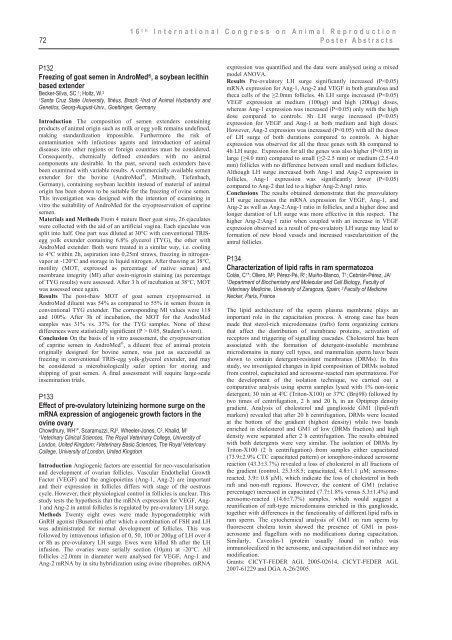Reproduction in Domestic Animals - Facultad de Ciencias Veterinarias
Reproduction in Domestic Animals - Facultad de Ciencias Veterinarias
Reproduction in Domestic Animals - Facultad de Ciencias Veterinarias
Create successful ePaper yourself
Turn your PDF publications into a flip-book with our unique Google optimized e-Paper software.
16 t h International Congress on Animal <strong>Reproduction</strong><br />
72 Poster Abstracts<br />
P132<br />
Freez<strong>in</strong>g of goat semen <strong>in</strong> AndroMed ® , a soybean lecith<strong>in</strong><br />
based exten<strong>de</strong>r<br />
Becker-Silva, SC. 1 ; Holtz, W. 2<br />
1Santa Cruz State University, Ilhéus, Brazil; 2 Inst of Animal Husbandry and<br />
Genetics, Georg-August-Univ., Goett<strong>in</strong>gen, Germany<br />
Introduction The composition of semen exten<strong>de</strong>rs conta<strong>in</strong><strong>in</strong>g<br />
products of animal orig<strong>in</strong> such as milk or egg yolk rema<strong>in</strong>s un<strong>de</strong>f<strong>in</strong>ed,<br />
mak<strong>in</strong>g standardization impossible. Furthermore the risk of<br />
contam<strong>in</strong>ation with <strong>in</strong>fectious agents and <strong>in</strong>troduction of animal<br />
diseases <strong>in</strong>to other regions or foreign countries must be consi<strong>de</strong>red.<br />
Consequently, chemically <strong>de</strong>f<strong>in</strong>ed exten<strong>de</strong>rs with no animal<br />
components are <strong>de</strong>sirable. In the past, several such exten<strong>de</strong>rs have<br />
been exam<strong>in</strong>ed with variable results. A commercially available semen<br />
exten<strong>de</strong>r for the bov<strong>in</strong>e (AndroMed ® , M<strong>in</strong>itueb, Tiefenbach,<br />
Germany), conta<strong>in</strong><strong>in</strong>g soybean lecith<strong>in</strong> <strong>in</strong>stead of material of animal<br />
orig<strong>in</strong> has been shown to be suitable for the freez<strong>in</strong>g of ov<strong>in</strong>e semen.<br />
This <strong>in</strong>vestigation was <strong>de</strong>signed with the <strong>in</strong>tention of exam<strong>in</strong><strong>in</strong>g <strong>in</strong><br />
vitro the suitability of AndroMed for the cryopreservation of capr<strong>in</strong>e<br />
semen.<br />
Materials and Methods From 4 mature Boer goat sires, 26 ejaculates<br />
were collected with the aid of an artificial vag<strong>in</strong>a. Each ejaculate was<br />
split <strong>in</strong>to half. One part was diluted at 30°C with conventional TRISegg<br />
yolk exten<strong>de</strong>r conta<strong>in</strong><strong>in</strong>g 6.8% glycerol (TYG), the other with<br />
AndroMed exten<strong>de</strong>r. Both were treated <strong>in</strong> a similar way, i.e. cool<strong>in</strong>g<br />
to 4°C with<strong>in</strong> 2h, aspiration <strong>in</strong>to 0,25ml straws, freez<strong>in</strong>g <strong>in</strong> nitrogenvapor<br />
at -120°C and storage <strong>in</strong> liquid nitrogen. After thaw<strong>in</strong>g at 38°C,<br />
motility (MOT, expressed as percentage of native semen) and<br />
membrane <strong>in</strong>tegrity (MI) after eos<strong>in</strong>-nigros<strong>in</strong> sta<strong>in</strong><strong>in</strong>g (as percentage<br />
of TYG results) were assessed. After 3 h of <strong>in</strong>cubation at 38°C, MOT<br />
was assessed once aga<strong>in</strong>.<br />
Results The post-thaw MOT of goat semen cryopreserved <strong>in</strong><br />
AndroMed diluent was 54% as compared to 55% <strong>in</strong> semen frozen <strong>in</strong><br />
conventional TYG exten<strong>de</strong>r. The correspond<strong>in</strong>g MI values were 118<br />
and 100%. After 3h of <strong>in</strong>cubation, the MOT for the AndroMed<br />
samples was 31% vs. 37% for the TYG samples. None of these<br />
differences were statistically significant (P > 0.05, Stu<strong>de</strong>nt’s t-test).<br />
Conclusion On the basis of <strong>in</strong> vitro assessment, the cryopreservation<br />
of capr<strong>in</strong>e semen <strong>in</strong> AndroMed ® , a diluent free of animal prote<strong>in</strong><br />
orig<strong>in</strong>ally <strong>de</strong>signed for bov<strong>in</strong>e semen, was just as successful as<br />
freez<strong>in</strong>g <strong>in</strong> conventional TRIS-egg yolk-glycerol exten<strong>de</strong>r, and may<br />
be consi<strong>de</strong>red a microbiologically safer option for stor<strong>in</strong>g and<br />
shipp<strong>in</strong>g of goat semen. A f<strong>in</strong>al assessment will require large-scale<br />
<strong>in</strong>sem<strong>in</strong>ation trials.<br />
P133<br />
Effect of pre-ovulatory lute<strong>in</strong>iz<strong>in</strong>g hormone surge on the<br />
mRNA expression of angiogeneic growth factors <strong>in</strong> the<br />
ov<strong>in</strong>e ovary<br />
Chowdhury, WH 1 *, Scaramuzzi, RJ 2 , Wheeler-Jones, C 2 , Khalid, M 1<br />
1Veter<strong>in</strong>ary Cl<strong>in</strong>ical Sciences, The Royal Veter<strong>in</strong>ary College, University of<br />
London, United K<strong>in</strong>gdom; 2 Veter<strong>in</strong>ary Basic Sciences, The Royal Veter<strong>in</strong>ary<br />
College, University of London, United K<strong>in</strong>gdom<br />
Introduction Angiogenic factors are essential for neo-vascularisation<br />
and <strong>de</strong>velopment of ovarian follicles. Vascular Endothelial Growth<br />
Factor (VEGF) and the angiopoiet<strong>in</strong>s (Ang-1, Ang-2) are important<br />
and their expression <strong>in</strong> follicles differs with stage of the oestrous<br />
cycle. However, their physiological control <strong>in</strong> follicles is unclear. This<br />
study tests the hypothesis that the mRNA expression for VEGF, Ang-<br />
1 and Ang-2 <strong>in</strong> antral follicles is regulated by pre-ovulatory LH surge.<br />
Methods Twenty eight ewes were ma<strong>de</strong> hypogonadotrphic with<br />
GnRH agonist (Buserel<strong>in</strong>) after which a comb<strong>in</strong>ation of FSH and LH<br />
was adm<strong>in</strong>istrated for normal <strong>de</strong>velopment of follicles. This was<br />
followed by <strong>in</strong>travenous <strong>in</strong>fusion of 0, 50, 100 or 200μg of LH over 4<br />
or 8h as pre-ovulatory LH surge. Ewes were killed 8h after the LH<br />
<strong>in</strong>fusion. The ovaries were serially section (10μm) at -20°C. All<br />
follicles ≥2.0mm <strong>in</strong> diameter were analysed for VEGF, Ang-1 and<br />
Ang-2 mRNA by <strong>in</strong> situ hybridization us<strong>in</strong>g ov<strong>in</strong>e riboprobes. mRNA<br />
expression was quantified and the data were analysed us<strong>in</strong>g a mixed<br />
mo<strong>de</strong>l ANOVA.<br />
Results Pre-ovulatory LH surge significantly <strong>in</strong>creased (P

















